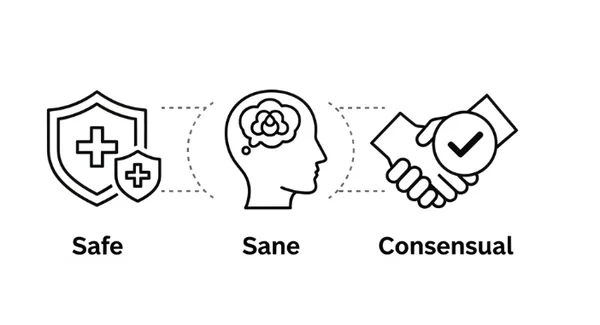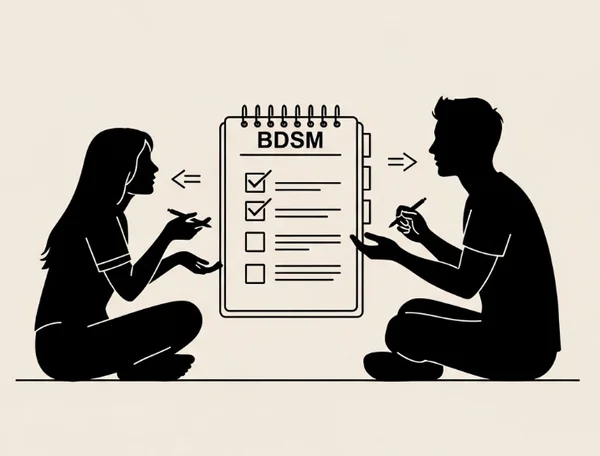Safe BDSM Practices: SSC & Consent in Kink
Your Essential Guide to Safe, Sane, Consensual Kink & BDSM
Exploring the realms of kink and BDSM can be an exciting and deeply fulfilling journey of self-discovery and connection. However, paramount to any exploration is ensuring that all activities are grounded in safe BDSM practices. What are the golden rules of kink? This guide delves into the foundational principles of SSC BDSM (Safe, Sane, Consensual), modern frameworks like RACK and PRICK, and the crucial roles of BDSM negotiation, safe words, and BDSM aftercare. Understanding and implementing these kink safety rules is non-negotiable for ethical and enjoyable play. While KinkTest.net helps you discover your preferences, this guide helps you explore them responsibly.
What is SSC? The Cornerstone of Safe Kink Practices
What is SSC in BDSM? For decades, SSC has been the foundational mantra for safe kink practices, providing a simple yet powerful framework.
Prioritizing Physical and Emotional Well-being
The "Safe" in SSC emphasizes the importance of minimizing genuine physical and emotional harm. This involves risk assessment for any activity, understanding potential dangers, using appropriate techniques and equipment (if any), and prioritizing the emotional safety and well-being of all participants. It's about playing responsibly and being aware of limits.
Ensuring Clear Minds and Informed Decisions
"Sane" refers to the necessity of all participants being of sound mind and capable of making informed decisions. This generally means engaging with mental clarity, free from substances that impair judgment or the ability to consent fully. It’s about understanding consequences and ensuring everyone is participating willingly and lucidly.
The Unwavering Importance of Enthusiastic Consent
This is the absolute heart of SSC and all ethical kink: "Consensual." It means enthusiastic agreement from everyone involved, for every activity, every time. Ongoing consent is key; it can be withdrawn at any point, and there should be absolutely no coercion or pressure. True consent kink is freely given and affirmed.

Beyond SSC: Modern Frameworks like RACK and PRICK
While SSC remains vital, the BDSM community has also developed more nuanced frameworks to address the complexities of BDSM safety. What are alternatives to SSC?
RACK: Risk-Aware Consensual Kink Explained
RACK acknowledges that not all BDSM activities are inherently "safe" in the everyday sense of the word. Instead, it emphasizes being risk-aware. This means participants discuss and understand the potential informed risk involved in an activity and consensually agree to accept those risks. Personal responsibility and thorough risk negotiation are central.
PRICK: Personal Responsibility, Informed Consent, Communication, Kindness
PRICK expands on these ideas, highlighting:
- Personal Responsibility: Each individual is accountable for their actions and well-being.
- Informed Consent: Consent must be based on a full understanding of what's involved.
- Communication: Open, honest, and continuous dialogue is essential.
- Kindness: Treating partners with respect, empathy, and care, even during intense play. These frameworks encourage clear communication protocols and respectful interaction.
Why These Nuanced Approaches Matter in BDSM Safety
These evolving ethics reflect a deeper understanding within community standards. They encourage a more proactive and detailed approach to safer exploration, acknowledging that "safe" can be subjective and requires ongoing dialogue rather than a one-size-fits-all rule.
BDSM Negotiation: The Art of Setting Boundaries and Expectations
Why is BDSM negotiation so important? Clear and thorough communication before any play begins is fundamental to safe BDSM practices and establishing BDSM boundaries.
Why Pre-Scene Negotiation is Non-Negotiable
Pre-scene negotiation is where desires are discussed, limits are set, and expectations are aligned. This helps in avoiding misunderstandings, preventing accidental boundary crossings, and building trust between partners. It ensures everyone is on the same page and feels respected.
Key Topics to Cover: Limits, Desires, Fears, and Triggers
A comprehensive negotiation should cover:
- Hard limits: Things that are absolutely off-limits and will not be done.
- Soft limits: Things that might be okay under certain conditions or that one is hesitant about but open to discussing.
- Desired experiences: What participants hope to get out of the scene.
- Fears and anxieties.
- Trigger warnings: Any topics, words, or actions that could cause significant distress. Understanding these is key to crafting a mutually enjoyable experience.
Documenting Agreements (Optional but Recommended)
For clarity, especially with new partners or complex scenes, some find it helpful to have a written consent form or a shared kink list outlining agreed-upon activities and limits. This aids in maintaining a shared understanding.

Safe Words in BDSM: Your Lifeline for Communication
What are safe words and why are they used in BDSM? During intense play, normal verbal cues might be ambiguous or part of the role-play. Safe words in BDSM provide an unambiguous communication channel.
The Purpose of Safe Words: Ensuring Control and Consent
Safe words are a critical stop signal, allowing the person in a submissive or vulnerable role to maintaining control over their experience and clearly withdraw or modify consent at any time, ensuring that all interactions align with respecting limits.
Common Safe Word Systems (Red/Yellow/Green)
The traffic light system is widely recognized:
- "Red" (or a mutually agreed-upon unambiguous word): Means STOP immediately. All activity ceases without question.
- "Yellow" (or similar): Means "slow down," "check-in," "I'm nearing a limit," or "I'm unsure."
- "Green" (or similar, less common as a formal safe word): Can mean "all good, continue," but clear ongoing enthusiastic consent is always preferred over relying on green. This provides clear signals for universal understanding.
What to Do When a Safe Word is Used: Immediate Action Required
When a safe word (especially "Red" or "Yellow") is used, the dominant or active partner must stop play instantly and check-in with the other person, offering provide support and addressing their needs. Ignoring a safe word is a serious breach of trust and consent.

The Importance of BDSM Aftercare: Nurturing Post-Scene Well-being
What is BDSM aftercare? The experience doesn't just end when the "scene" is over. Post-scene well-being is crucial, and that's where aftercare bdsm comes in.
What is Aftercare and Why is it Essential?
Aftercare refers to the period of care, comfort, and emotional support provided after a BDSM scene, especially an intense one. It helps participants transition back to a more "normal" headspace, process emotions, and reinforce connection. It can involve physical comfort and reconnecting on a gentler level.
Tailoring Aftercare to Individual and Scene Needs
Effective aftercare is not one-size-fits-all. It should be tailored to personal preferences, the intensity of play, and the specific emotional needs of those involved. What one person finds comforting, another might not. This should be discussed during negotiation.
Examples of Aftercare Activities: From Cuddling to Conversation
Common aftercare activities include:
-
Cuddling, holding, or gentle touch.
-
Verbal reassurance and praise.
-
Providing hydration (water) and snacks.
-
Offering comfort items like blankets.
-
Quiet conversation or simply being present together. The goal is to ensure everyone feels safe, valued, and cared for.

Embrace Kink Safely: Your Commitment to Ethical Play
The journey into kink and BDSM is rich with potential for pleasure, growth, and profound connection. However, this potential can only be fully and ethically realized when built on a bedrock of safe BDSM practices. Internalizing principles like SSC BDSM, RACK, and PRICK, and diligently practicing clear BDSM negotiation, using safe words, and providing thoughtful BDSM aftercare are not optional extras—they are the very essence of responsible and ethical kink.
While KinkTest.net empowers you to understand your preferences, applying these safety principles is your personal commitment to yourself and your partners.
Understanding your own preferences is the first step to safe and consensual exploration. Discover more about yourself with the anonymous Kink Test on KinkTest.net.
Safe BDSM Practices FAQs: Your Key Safety Questions Answered
Here are some key questions about ensuring safety in BDSM:
-
What's the most important rule in safe BDSM play?
Without a doubt, it's consent kink! Enthusiastic, informed, and ongoing consent from all participants is the absolute, non-negotiable foundation of any ethical kink or BDSM activity.
-
Can BDSM be safe if it involves pain?
Yes, safe pain play is possible when approached with knowledge, caution, and clear consent. This involves understanding anatomy, types of sensation, risk mitigation techniques, and constant communication, including effective use of safe words.
-
How do you establish consent if someone is non-verbal during a scene?
Non-verbal consent BDSM requires pre-negotiated, clear, and unambiguous non-verbal signals for "yes," "no," "more," "less," and safe words (e.g., a specific number of taps, a dropped object). This must be crystal clear to all parties before play begins.
-
What if my partner and I disagree on a boundary during BDSM negotiation?
If there's a BDSM boundary disagreement, the boundary of the person who is less comfortable or unwilling always takes precedence. Never pressure someone to cross a stated hard limit. Respecting boundaries is key to trust and safety.
-
Is it okay to not want aftercare after every BDSM scene?
Yes, is aftercare always needed is a common question. While highly recommended, especially after intense scenes, individual needs vary. This should be discussed during negotiation. Some may prefer quiet alone time. However, checking in, even briefly, is generally good practice.